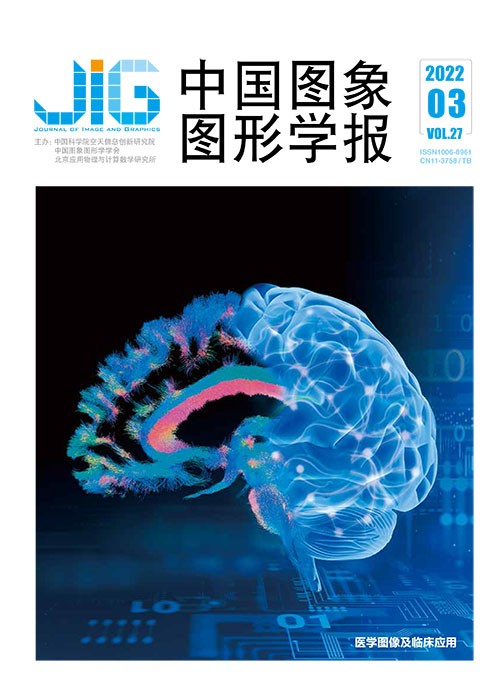
CT图像肺及肺病变区域分割方法综述
摘 要
计算机断层扫描(computed tomography,CT)技术能为新冠肺炎(corona virus disease 2019,COVID-19)和肺癌等肺部疾病的诊断与治疗提供更全面的信息,但是由于肺部疾病的类型多样且复杂,使得对肺CT图像进行高质量的肺病变区域分割成为计算机辅助诊断的重难点问题。为了对肺CT图像的肺及肺病变区域分割方法的现状进行全面研究,本文综述了近年国内外发表的相关文献:对基于区域和活动轮廓的肺CT图像传统分割方法的优缺点进行比较与总结,传统的肺CT图像分割方法因其实现原理简单且分割速度快等优点,早期使用较多,但其存在分割精度不高的缺点,目前仍有不少基于传统方法的改进策略;重点分析了基于卷积神经网络(convolutional neural network,CNN)、全卷积网络(fully convolutional network,FCN)、U-Net和生成对抗网络(generative adversarial network,GAN)的肺CT图像分割网络结构改进模型的研究进展,基于深度学习的分割方法具有分割精度高、迁移学习能力强和鲁棒性高等优点,特别是在辅助诊断COVID-19病例时,基于深度学习方法的性能明显优于基于传统方法的性能;介绍肺及肺病变区域分割的常用数据集和评价指标,在解决如COVID-19数据样本量少等问题时,使用GAN以合成高质量的对抗性图像用以扩充数据集,从而增加训练样本的数量和多样性;讨论了肺CT图像的肺及肺病变区域的高精度分割策略的研究趋势、现有挑战和未来的研究方向。
关键词
Review of human lung and lung lesion regions segmentation methods based on CT images
Feng Longfeng1, Chen Ying1, Zhou Taohui1, Hu Fei1, Yi Zhen2(1.School of Software, Nanchang Hangkong University, Nanchang 330063, China;2.Department of Radiology, Jiangxi Provincial Cancer Hospital, Nanchang 330029, China) Abstract
Lung disease like corona virus disease 2019(COVID-19) and lung cancer endanger the health of human beings. Early screening and treatment can significantly decrease the mortality of lung diseases. Computed tomography (CT) technology can be an effective information collection method for the diagnosis and treatment of lung diseases. CT-based lung lesion region image segmentation is a key step in lung disease screening. High quality lung lesion region segmentation can effectively improve the level of early stage diagnosis and treatment of lung diseases. However, high-quality lung lesion region segmentation in lung CT images has become a challenging issue in computer-aided diagnosis due to the diversity and complexity of lung diseases. Our research reviews the relevant literature recently. First, it is compared and summarized the pros and cons of traditional segmentation methods of lung CT image based on region and active contour. The region-based method uses the similarity and difference of features to guide image segmentation, mainly including threshold method, region growth method, clustering method and random walk method. The active-contour-based method is to set an initial contour line with decreasing energy. The contour line deforms in the internal energy derived from its own characteristics and the external energy originated from image characteristics. Its movement is in accordance with the principle of minimum energy until the energy function is in minimization and the contour line stops next to the boundary of lung region. The active contour method is divided into parametric active contour method and geometric active contour method in terms of the contour curve analysis. Low segmentation accuracy lung CT image segmentation methods are widely used in the early stage diagnosis. Next, the improved model analysis of lung CT image segmentation network structure is based on convolutional neural networks (CNNs), fully convolutional networks (FCNs), and generative adversarial network (GAN). In respect of the CNN-based deep learning segmentation methods, the segmentation methods of lung and lung lesion region can be divided into two-dimensional and three-dimensional methods in terms of the dimension of convolution kernel, the segmentation methods of lung and lung lesion region can also be divided into two-dimensional and three-dimensional methods based on the dimension of convolution kernel for the FCN-based deep learning segmentation methods. In respect of the U-Net based lung CT image segmentation methods, it can be divided into solo network lung CT image segmentation method and multi network lung CT image segmentation method according to the form of U-Net architecture. Due to the CT image containing COVID-19 infection area is very different from the ordinary lung CT imageand the differentiated segmentation characteristics of the two in the same network, the solo network lung CT image segmentation method can be analyzed that whether the data-set contains COVID-19 or not. The multi-network lung CT image segmentation method can be divided into cascade U-Net and dual path U-Net based on the option of serial mode or parallel mode. For the GAN-based lung CT image segmentation methods, it can be divided into GAN models based on network architecture, generator and other methods according to the ways to improve the different architectures of GAN. Deep-learning-based segmentation method has the advantages of high segmentation accuracy, strong transfer learning ability and high robustness. In particular, the auxiliary diagnosis of COVID-19 cases analysis is significantly qualified based on deep learning. Next, the common datasets and evaluation indexes of lung and lung lesion region segmentation are illustrated, including almost 10 lung CT open datasets, such as national lung screening test(NLST) dataset, computer vision and image analysis international early lung cancer action plan database(VIA/I-ELCAP) dataset, lung image database consortium and image database resource initiative(LIDC-IDRI) dataset and Nederlands-Leuvens Longkanker Screenings Onderzoek(NELSON) dataset, and 7 COVID-19 lung CT datasets analysis. It also demonstrates that the related lung CT images datasets is provided based on five large-scale competitions, including TIANCHI dataset, lung nodule analysis 16(LUNA16) dataset, Lung Nodule Database(LNDb) dataset, Kaggle Data Science Bowl 2017(Kaggle DSB) 2017 dataset and Automatic Nodule Detection 2009(ANODE09) dataset, respectively. Our 8 evaluation index is commonly used to evaluate the quality of lung CT image segmentation model, including involved Dice similarity coefficient, Jaccard similarity coefficient, accuracy, precision, false positive rate, false negative rate, sensitivity and specificity, respectively. To increase the number and diversity of training samples, GAN is used to synthesize high-quality adversarial images to expand the dataset. At the end, the prospects, challenges and potentials of CT-based high-precision segmentation strategies are critical reviewed for lung and lung lesion regions. Because the special structure of U-Net can effectively extract target features and restore the information loss derived from down sampling, it does not need a large number of samples for training to achieve high segmentation effect. Therefore, it is necessary to segment lung and lung lesions based on U-Net. The integration of GAN and U-Net is to improve the segmentation accuracy of lung and lung lesion areas. GAN-based network architecture is to extend the dataset for good training quality. The further U-Net application has its priority for qualified segmentation consistently.
Keywords
computed tomography(CT) medical image segmentation lung CT image segmentation lung lesion region deep learning corona virus disease 2019(COVID-19)
|



 中国图象图形学报 │ 京ICP备05080539号-4 │ 本系统由
中国图象图形学报 │ 京ICP备05080539号-4 │ 本系统由